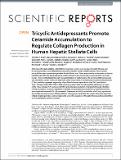Tricyclic Antidepressants Promote Ceramide Accumulation to Regulate Collagen Production in Human Hepatic Stellate Cells

View/
Author
Newcomb, Benjamin
Pondick, Joshua V.
York, Samuel R.
Motola, Daniel L.
Coant, Nicolas
Yi, Jae Kyo
Mao, Cungui
Bronova, Irina
Berdyshev, Evgeny V.
Hannun, Yusuf
Note: Order does not necessarily reflect citation order of authors.
Published Version
https://doi.org/10.1038/srep44867Metadata
Show full item recordCitation
Chen, J. Y., B. Newcomb, C. Zhou, J. V. Pondick, S. Ghoshal, S. R. York, D. L. Motola, et al. 2017. “Tricyclic Antidepressants Promote Ceramide Accumulation to Regulate Collagen Production in Human Hepatic Stellate Cells.” Scientific Reports 7 (1): 44867. doi:10.1038/srep44867. http://dx.doi.org/10.1038/srep44867.Abstract
Activation of hepatic stellate cells (HSCs) in response to injury is a key step in hepatic fibrosis, and is characterized by trans-differentiation of quiescent HSCs to HSC myofibroblasts, which secrete extracellular matrix proteins responsible for the fibrotic scar. There are currently no therapies to directly inhibit hepatic fibrosis. We developed a small molecule screen to identify compounds that inactivate human HSC myofibroblasts through the quantification of lipid droplets. We screened 1600 compounds and identified 21 small molecules that induce HSC inactivation. Four hits were tricyclic antidepressants (TCAs), and they repressed expression of pro-fibrotic factors Alpha-Actin-2 (ACTA2) and Alpha-1 Type I Collagen (COL1A1) in HSCs. RNA sequencing implicated the sphingolipid pathway as a target of the TCAs. Indeed, TCA treatment of HSCs promoted accumulation of ceramide through inhibition of acid ceramidase (aCDase). Depletion of aCDase also promoted accumulation of ceramide and was associated with reduced COL1A1 expression. Treatment with B13, an inhibitor of aCDase, reproduced the antifibrotic phenotype as did the addition of exogenous ceramide. Our results show that detection of lipid droplets provides a robust readout to screen for regulators of hepatic fibrosis and have identified a novel antifibrotic role for ceramide.Other Sources
http://www.ncbi.nlm.nih.gov/pmc/articles/PMC5359599/pdf/Terms of Use
This article is made available under the terms and conditions applicable to Other Posted Material, as set forth at http://nrs.harvard.edu/urn-3:HUL.InstRepos:dash.current.terms-of-use#LAACitable link to this page
http://nrs.harvard.edu/urn-3:HUL.InstRepos:32072075
Collections
- HMS Scholarly Articles [17920]
Contact administrator regarding this item (to report mistakes or request changes)


